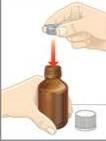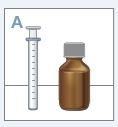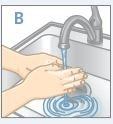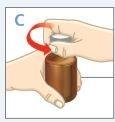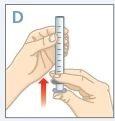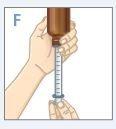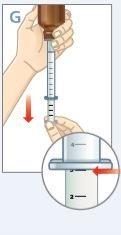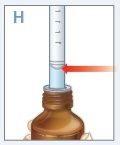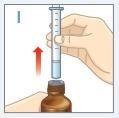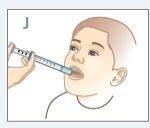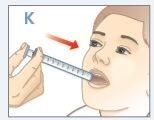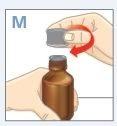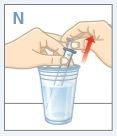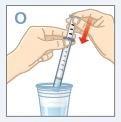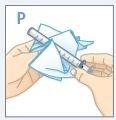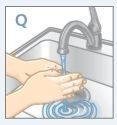
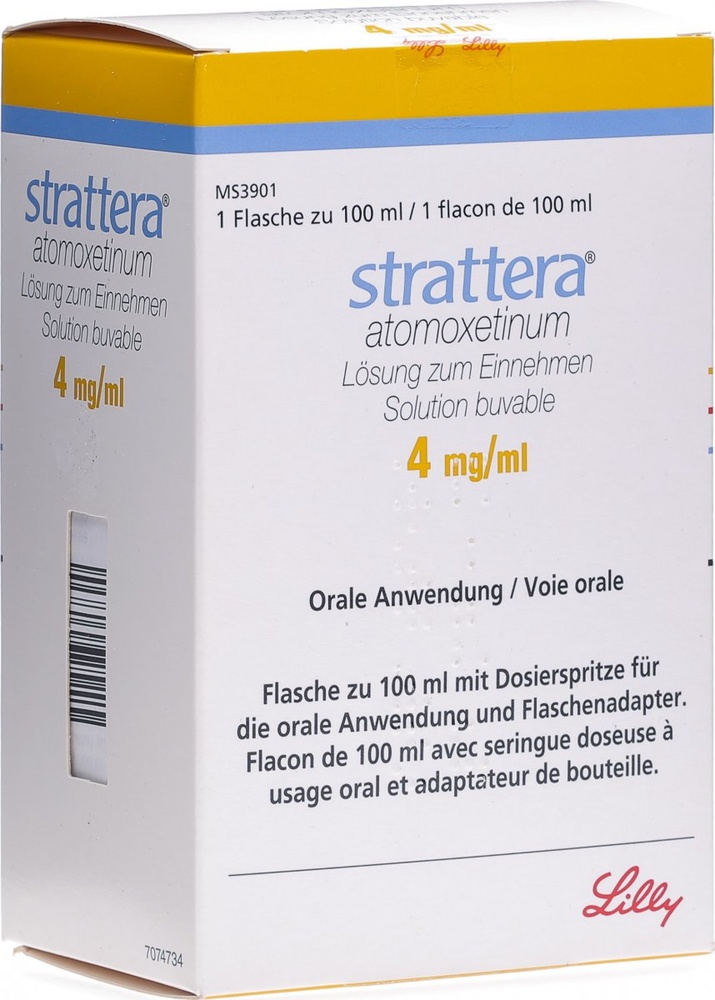
СТРАТТЕРА 4 мг/мл ОРАЛЬНЫЙ РАСТВОР

Спросите врача о рецепте на СТРАТТЕРА 4 мг/мл ОРАЛЬНЫЙ РАСТВОР

Инструкция по применению СТРАТТЕРА 4 мг/мл ОРАЛЬНЫЙ РАСТВОР
Введение
Инструкция: информация для пациента
Страттера 4мг/мл пероральная раствор
атомоксетин
Прочитайте внимательно всю инструкцию перед началом приема этого лекарства, поскольку она содержит важную информацию для вас.
- Сохраните эту инструкцию, поскольку вам может потребоваться перечитать ее.
- Если у вас есть какие-либо вопросы, проконсультируйтесь с вашим врачом или фармацевтом.
- Это лекарство было назначено только вам, и не следует давать его другим людям, даже если они имеют те же симптомы, что и вы, поскольку оно может нанести им вред.
- Если вы испытываете побочные эффекты, проконсультируйтесь с вашим врачом или фармацевтом, даже если они не указаны в этой инструкции. См. раздел 4.
Содержание инструкции:
- Что такое Страттера и для чего она используется
- Что вам нужно знать перед началом приема Страттеры
- Как принимать Страттеру
- Возможные побочные эффекты
- Хранение Страттеры
- Содержание упаковки и дополнительная информация
1. Что такое Страттера и для чего она используется
Для чего используетсяСтраттера содержит атомоксетин и используется для лечения синдрома дефицита внимания и гиперактивности (СДВГ). Она используется
- у детей от 6 лет
- у подростков
- у взрослых
Она используется только как часть комплексного лечения заболевания, которое также включает в себя немедикаментозные методы лечения, такие как консультирование или поведенческая терапия.
Она не используется для лечения СДВГ у детей младше 6 лет, поскольку неизвестно, работает ли препарат или является ли он безопасным для этой возрастной группы.
У взрослых Страттера используется для лечения СДВГ, когда симптомы очень проблематичны и влияют на работу или социальную жизнь, и когда были симптомы заболевания в детстве.
Как она работаетСтраттера увеличивает количество норадреналина в мозге. Это естественно произведенная химическая субстанция, которая увеличивает внимание и уменьшает импульсивность и гиперактивность у пациентов с СДВГ. Это лекарство было назначено вам, чтобы помочь контролировать симптомы СДВГ. Это лекарство не является стимулятором и, следовательно, не вызывает привыкание. Может потребоваться несколько недель с начала лечения до полного улучшения симптомов.
О СДВГДети и подростки с СДВГ испытывают:
- трудности с сидением
- трудности с концентрацией внимания
Это не ваша вина, что вы не можете делать эти вещи. Многим детям и подросткам это бывает трудно. Однако у пациентов с СДВГ это может вызывать проблемы в повседневной жизни. Дети и подростки с СДВГ могут иметь трудности с обучением и выполнением домашних заданий. У них могут быть трудности с поведением в доме, школе или других местах. СДВГ не влияет на интеллект ребенка или подростка.
Взрослые с СДВГ испытывают трудности с теми же вещами, что и дети, однако это может привести к проблемам с:
- работой
- отношениями
- низкой самооценкой
- образованием
2. Что вам нужно знать перед началом приема Страттеры
Не принимайте Страттеру, если вы
- аллергичны к атомоксетину или любому другому компоненту этого лекарства (перечисленному в разделе 6).
- принимали в течение последних двух недель лекарство, называемое ингибитором моноаминоксидазы (ИМАО), например, фенелзин. ИМАО иногда используются для лечения депрессии и других психических расстройств; прием Страттеры вместе с ИМАО может вызвать серьезные побочные эффекты или угрожать жизни. Кроме того, вы должны подождать至少 14 дней после окончания лечения Страттерой, прежде чем принимать ИМАО.
- имеете глазное заболевание, называемое узкоугольной глаукомой (повышение давления в глазах).
- имеете серьезные проблемы с сердцем, которые могут ухудшиться при увеличении частоты сердечных сокращений и/или артериального давления, что может произойти при приеме Страттеры.
- имеете серьезные проблемы с кровеносными сосудами мозга, такие как инсульт, часть воспаленного и ослабленного кровеносного сосуда (аневризма) или суженные или заблокированные кровеносные сосуды.
- имеете опухоль надпочечной железы (феохромоцитома).
Не принимайте Страттеру, если вы соответствуете любому из вышеуказанных случаев. Если вы не уверены, проконсультируйтесь с вашим врачом или фармацевтом перед приемом Страттеры, поскольку Страттера может ухудшить эти проблемы.
Предостережения и меры предосторожности
И взрослые, и дети должны учитывать следующие предостережения и меры предосторожности. Проконсультируйтесь с вашим врачом или фармацевтом перед началом приема Страттеры, если у вас:
- мысли или попытки самоубийства.
- проблемы с сердцем (включая врожденные пороки сердца) или увеличенная частота сердечных сокращений. Страттера может увеличить вашу частоту сердечных сокращений (пульс). Были зарегистрированы случаи внезапной смерти у пациентов с пороками сердца.
- повышенное артериальное давление. Страттера может увеличить ваше артериальное давление.
- пониженное артериальное давление. Страттера может вызвать головокружение или обморок у людей с пониженным артериальным давлением.
- проблемы с внезапными изменениями артериального давления или частоты сердечных сокращений.
- сердечно-сосудистые заболевания или истории инсульта.
- проблемы с печенью. Вам может потребоваться уменьшенная доза.
- психотические реакции, включая галлюцинации (слышание голосов или видение несуществующих вещей), веру в несуществующие вещи или проявление подозрительности.
- мания (чувство возбуждения или чрезмерного возбуждения, что приводит к необычному поведению) и агитация.
- агрессивные чувства.
- чувства враждебности и гнева (враждебность).
- история эпилепсии или судорог по любой другой причине. Страттера может увеличить частоту судорог.
- необычное состояние духа (колебания настроения) или чувство несчастья.
- повторяющиеся спазмы, трудно контролируемые, любой части тела или повторение звуков и слов.
Проконсультируйтесь с вашим врачом или фармацевтом, если у вас есть какие-либо из вышеуказанных симптомов перед началом лечения, поскольку Страттера может ухудшить эти проблемы. Ваш врач будет следить за тем, как лекарство влияет на вас.
Лечение Страттерой может сделать вас агрессивным, враждебным или жестоким; или ухудшить эти симптомы, если они были присутствуют до лечения. Она также может вызвать необычные изменения в поведении или состоянии духа (включая физическую агрессию, угрожающее поведение и мысли о причинении вреда другим). Если вы или ваши члены семьи и/или друзья заметили какие-либо из этих реакций, немедленно проконсультируйтесь с вашим врачом или фармацевтом.
Серотониновый синдром
Серотониновый синдром - это потенциально опасное для жизни состояние, которое может возникнуть при приеме Страттеры в сочетании с другими лекарствами (см. раздел 2 "Другие лекарства и Страттера"). Признаки и симптомы серотонинового синдрома могут включать комбинацию следующих: путаница, беспокойство, отсутствие координации и жесткость, галлюцинации, кома, быстрые сердечные сокращения, повышение температуры тела, быстрые изменения артериального давления, потоотделение, покраснение, дрожь, гиперактивные рефлексы, тошнота, рвота и диарея. Свяжитесь с врачом или немедленно обратитесь в ближайший госпиталь, если вы считаете, что у вас возник серотониновый синдром.
Исследования, которые ваш врач проведет перед началом приема Страттеры
Эти исследования проводятся для определения того, является ли Страттера подходящим лекарством для вас.
Ваш врач измерит ваше
- артериальное давление и частоту сердечных сокращений (пульс) до и во время приема Страттеры
- вес и рост, если во время приема Страттеры вы являетесь ребенком или подростком
Ваш врач спросит вас о:
- других лекарствах, которые вы принимаете
- наличии семейной истории внезапной смерти
- любых других медицинских проблемах (таких как проблемы с сердцем), которые у вас или вашей семьи могут быть.
Важно предоставить всю возможную информацию. Это поможет вашему врачу определить, является ли Страттера подходящим лекарством для вас. Ваш врач может решить провести другие медицинские исследования перед началом лечения этим лекарством.
Другие лекарства и Страттера
Сообщите вашему врачу или фармацевту, если вы принимаете, недавно принимали или можете принять любое другое лекарство. Это включает лекарства, приобретенные без рецепта. Ваш врач решит, можете ли вы принимать Страттеру с другими лекарствами, и в некоторых случаях ваш врач может потребовать调整 дозы или более медленного увеличения.
Не принимайте Страттеру с лекарствами, называемыми ИМАО (ингибиторами моноаминоксидазы), принимаемыми для лечения депрессии. См. раздел 2 "Не принимайте Страттеру".
Если вы принимаете другие лекарства, Страттера может повлиять на их правильное функционирование или вызвать побочные эффекты. Если вы принимаете любое из следующих лекарств, проконсультируйтесь с вашим врачом или фармацевтом перед приемом Страттеры:
- лекарства, увеличивающие артериальное давление или используемые для его контроля.
- лекарства, такие как антидепрессанты, например, имипрамин, венлафаксин, миртазапин, флуоксетин и пароксетин.
- некоторые средства от кашля и простуды, содержащие лекарства, которые могут повлиять на артериальное давление. Когда вы покупаете такие продукты, важно проконсультироваться с вашим фармацевтом.
- некоторые лекарства, используемые для лечения психических расстройств.
- лекарства, известные как увеличивающие риск судорог.
- некоторые лекарства, которые делают Страттеру более длительным в организме, чем обычно (такие как хинидин и тербинафин).
- сальбутамол (лекарство для лечения астмы) при пероральном приеме или инъекции может вызвать ощущение ускорения сердечных сокращений, но это не ухудшит вашу астму.
Лекарства, описанные ниже, могут увеличить риск развития аномального сердечного ритма при приеме Страттеры:
- лекарства, используемые для контроля сердечного ритма,
- лекарства, изменяющие содержание солей в крови,
- лекарства для профилактики и лечения малярии,
- антибиотики (такие как эритромицин и моксифлоксацин).
Если вы не уверены, входят ли лекарства, которые вы принимаете, в список лекарств, упомянутый выше, проконсультируйтесь с вашим врачом или фармацевтом перед приемом Страттеры.
Страттера может повлиять на или быть подвержена влиянию других лекарств. Это включает:
- Некоторые антидепрессанты, опиоиды, такие как трамадол, и лекарства, используемые для лечения мигрени, называемые триптанами. Эти лекарства могут взаимодействовать со Страттерой и вызвать серотониновый синдром, потенциально опасное для жизни состояние. (См. раздел 2, Предостережения и меры предосторожности, Серотониновый синдром).
Беременность и лактация
Неизвестно, может ли это лекарство повлиять на плод или попасть в грудное молоко.
- Это лекарство не должно приниматься во время беременности, если только ваш врач не скажет вам обратное.
- Вам следует избегать приема этого лекарства, если вы кормите грудью, или прекратить кормление грудью.
Если вы:
- беременны или кормите грудью,
- думаете, что могли бы быть беременными, или планируете забеременеть,
- планируете кормить грудью,
проконсультируйтесь с вашим врачом или фармацевтом перед использованием этого лекарства.
Вождение и использование машин
Страттера может вызвать у вас усталость, сонливость или головокружение. Будьте осторожны, если вы водите или используете машины, пока не узнаете, как Страттера влияет на вас. Если вы чувствуете усталость, сонливость или головокружение, не следует водить или использовать машины.
Важная информация о пероральной растворе
Эта пероральная раствор может раздражать глаза. Если пероральная раствор попадет в глаза, промойте их немедленно большим количеством воды и проконсультируйтесь с вашим врачом. Если руки или любая другая часть тела соприкоснутся с пероральной раствор, вам также следует промыть их водой как можно быстрее.
Страттера пероральная раствор содержит сорбитол, натрий, бензоат натрия и пропиленгликоль
Это лекарство содержит 32,97 мг сорбитола в каждом мл. Сорбитол является источником фруктозы. Если ваш врач сказал вам (или вашему ребенку), что у вас есть непереносимость некоторых сахаров, или если у вас диагностирована врожденная непереносимость фруктозы (ВНФ), редкое генетическое заболевание, при котором пациент не может расщеплять фруктозу, проконсультируйтесь с вашим врачом перед приемом этого лекарства.
Это лекарство содержит 2,64 мг натрия (основного компонента столовой соли) в каждом мл. Это эквивалентно 3,3% максимальной рекомендуемой суточной нормы потребления натрия для взрослого.
Это лекарство содержит 0,8 мг бензоата натрия в каждом мл.
Это лекарство содержит 9,8 мг пропиленгликоля в каждом мл.
3. Как принимать Страттеру
?
- Дети не должны принимать это лекарство без помощи взрослого.
- Если вы чувствуете сонливость или тошноту, когда принимаете Страттеру один раз в день, ваш врач может изменить режим приема лекарства на два раза в день.
- Лекарство можно принимать с или без пищи.
- Пероральная раствор не должна смешиваться с пищей или водой, поскольку это может уменьшить количество принятого лекарства или сделать вкус менее приятным.
- Прием лекарства всегда в одно и то же время каждый день может помочь вам запомнить, что вам нужно его принять.
Страттера пероральная раствор доступна в бутылке. Это часть упаковки, которая также включает устройство для дозирования, состоящее из пероральной дозирующей шприца на 10 мл, градуированного в долях 1 мл, и адаптера для бутылки. Чтобы увидеть инструкции по использованию адаптера и дозирующего шприца, прочитайте инструкции пользователя, включенные в упаковку.
Какое количество приниматьЕсли вы ребенок (от 6 лет) или подросток:Ваш врач укажет дозу Страттеры, которую вам нужно принимать, в зависимости от вашего веса. Обычно вам нужно начать с низкой дозы, прежде чем увеличить ее, в зависимости от вашего веса.
- До 70 кг веса: начиная с суточной дозы 0,5 мг на кг веса в течение минимум 7 дней. Ваш врач затем решит, следует ли увеличить дозу до обычной поддерживающей дозы 1,2 мг на кг веса и в день.
- Более 70 кг веса: начиная с суточной дозы Страттеры 40 мг в течение минимум 7 дней. Ваш врач затем решит, следует ли увеличить дозу до обычной поддерживающей дозы 80 мг в день. Максимальная суточная доза составляет 100 мг.
Взрослые
- Страттера должна начинаться с суточной дозы 40 мг в течение минимум 7 дней. Ваш врач затем решит, следует ли увеличить дозу до обычной поддерживающей дозы 80-100 мг в день. Максимальная суточная доза составляет 100 мг.
Если у вас есть проблемы с печенью, ваш врач может порекомендовать уменьшенную дозу.
Если вы приняли слишком много СтраттерыВ случае передозировки или случайного приема проконсультируйтесь немедленно с вашим врачом или фармацевтом или позвоните в Центр токсикологической информации, телефон: 91 562 04 20, указав лекарство и количество, принятое вами. Симптомы, сообщенные наиболее часто после передозировки, включают желудочно-кишечные симптомы, сонливость, головокружение, дрожь и необычное поведение. Очень редко также сообщалось о серотониновом синдроме, потенциально опасном для жизни состоянии. (См. раздел 2, Предостережения и меры предосторожности, Серотониновый синдром).
Если вы пропустили прием СтраттерыЕсли вы пропустили дозу, примите другую как можно скорее, но не принимайте количество, превышающее суточную дозу в течение 24 часов. Не принимайте двойную дозу, чтобы компенсировать пропущенные дозы.
Если вы прекратите лечение СтраттеройЕсли вы перестанете принимать Страттеру, обычно не возникают побочные эффекты, но симптомы СДВГ могут возобновиться. Вам следует проконсультироваться с вашим врачом перед прекращением лечения.
Что ваш врач сделает во время лечения
Ваш врач проведет некоторые исследования
- до начала - он убедится, что Страттера безопасна и полезна для вас.
- после начала - исследования будут проводиться至少 каждые 6 месяцев, хотя они могут быть более частыми.
Исследования также будут проводиться при изменении дозы. Эти исследования включают:
- измерение роста и веса у детей и подростков
- измерение артериального давления и частоты сердечных сокращений
- проверку наличия проблем или ухудшения побочных эффектов во время приема Страттеры
Долгосрочное лечениеСтраттера не нуждается в постоянном приеме. Если вы принимаете Страттеру более года, ваш врач должен пересмотреть ваше лечение, чтобы проверить, является ли лекарство еще необходимым.
Если у вас есть какие-либо другие вопросы о использовании этого лекарства, проконсультируйтесь с вашим врачом или фармацевтом.
4. Возможные побочные эффекты
Как и все лекарства, это лекарство может вызывать побочные эффекты, хотя не все люди испытывают их. Хотя некоторые люди испытывают побочные эффекты, большинство считает, что Страттера помогает. Ваш врач расскажет вам об этих побочных эффектах.
Некоторые побочные эффекты могут быть серьезными. Если вы испытываете любой из следующих побочных эффектов, немедленно свяжитесь с вашим врачом.
Редкие(могут повлиять на до 1 из 100 человек)
- чувство или наличие очень быстрого сердечного ритма, аномального сердечного ритма
- мысль или чувство суицидальных намерений
- агрессивное чувство
- чувство враждебности и гнева (враждебность)
- изменения настроения
- тяжелая аллергическая реакция с симптомами
- отек лица и горла
- затруднение дыхания
- крапивница (маленькие красные пятна и зуд на коже)
- припадки
- психотические симптомы, включая галлюцинации (такие как слышание голосов или видение вещей, которые не существуют), веру в вещи, которые не являются правдой, или проявление подозрительности.
Дети и молодые люди в возрасте до 18 лет имеют более высокий риск испытывать побочные эффекты, такие как:
- мысль или чувство суицидальных намерений (могут повлиять на до 1 из 100 человек)
- изменения настроения (могут повлиять на до 1 из 10 человек)
У взрослых риск ниже(могут повлиять на до 1 из 1000 человек) испытывать побочные эффекты, такие как:
- припадки
- психотические симптомы, включая галлюцинации (такие как слышание голосов или видение вещей, которые не существуют), веру в вещи, которые не являются правдой, или проявление подозрительности.
Редкие(могут повлиять на до 1 из 1000 человек)
- повреждение печени
Прекратите лечение Страттерой и немедленно свяжитесь с вашим врачом, если出现 любой из следующих побочных эффектов:
- темная моча
- желтуха кожи и глаз
- боль в правом верхнем углу живота, прямо под ребрами
- чувство тошноты без объяснения
- усталость
- зуд
- чувство начала простуды
Другие побочные эффекты, которые были зарегистрированы, следующие. Если любой из них ухудшится, проконсультируйтесь с вашим врачом или фармацевтом.
Побочные эффекты очень часто(могут повлиять на более 1 из 10 человек) | |
ДЕТИ старше 6 лет и МОЛОДЫЕ ЛЮДИ | ВЗРОСЛЫЕ |
Эти эффекты могут исчезнуть после некоторого времени у большинства пациентов |
|
Побочные эффекты часто(могут повлиять на до 1 из 10 человек) | |
ДЕТИ старше 6 лет и МОЛОДЫЕ ЛЮДИ | ВЗРОСЛЫЕ |
|
|
Побочные эффекты редко(могут повлиять на до 1 из 100 человек) | |
ДЕТИ старше 6 лет и МОЛОДЫЕ ЛЮДИ | ВЗРОСЛЫЕ |
|
|
Побочные эффекты очень редко(могут повлиять на до 1 из 1000 человек) | |
ДЕТИ старше 6 лет и МОЛОДЫЕ ЛЮДИ | ВЗРОСЛЫЕ |
|
|
Неизвестная частота | |
ДЕТИ старше 6 лет и МОЛОДЫЕ ЛЮДИ | ВЗРОСЛЫЕ |
|
Влияние на ростКогда некоторые дети начинают принимать Страттеру, их рост (вес и высота) уменьшается. Однако, при длительном лечении дети восстанавливают нормальный вес и рост для своего возраста. Ваш врач будет следить за ростом и весом вашего ребенка. Если ваш ребенок не растет или набирает вес, как ожидается, ваш врач может изменить дозу Страттеры или временно прекратить лечение Страттерой.
Сообщение о побочных эффектахЕсли вы испытываете любой побочный эффект, проконсультируйтесь с вашим врачом или фармацевтом, даже если это возможные побочные эффекты, которые не указаны в этом описании. Вы также можете сообщить об этом напрямую через систему мониторинга безопасности лекарственных средств: https://www.notificaram.es. Сообщая о побочных эффектах, вы можете помочь предоставить больше информации о безопасности этого лекарства.
5. Хранение Страттеры
Храните это лекарство в недоступном для детей месте.
Не используйте это лекарство после даты истечения срока годности, указанной на упаковке и на флаконе после «CAD». Дата истечения срока годности - последний день месяца, указанного.
Не используйте пероральный раствор более 45 дней после первого открытия флакона.
Это лекарство не требует специальных условий хранения.
Лекарства не должны выбрасываться в канализацию или мусор. Сдавайте упаковку и лекарства, которые вам больше не нужны, в аптеку. Если у вас есть сомнения, спросите у вашего фармацевта, как избавиться от упаковки и лекарств, которые вам больше не нужны. Таким образом, вы поможете защитить окружающую среду.
6. Содержимое упаковки и дополнительная информация
Состав Страттеры 4мг/мл
- Активное вещество - гидрохлорид атомоксетина. Каждый мл перорального раствора содержит гидрохлорид атомоксетина в количестве, эквивалентном 4 мг атомоксетина.
- Другие компоненты - бензоат натрия (Е211), дигидрогенфосфат натрия дигидрат, фосфорная кислота, жидкий сорбитол (кристаллизируемый) Е420, ксилитол, искусственный малиновый вкус (содержащий пропиленгликоль Е1520), сукралоза, гидроксид натрия, очищенная вода.
Внешний вид продукта и содержимое упаковкиПероральный раствор, 4 мг/мл (прозрачный бесцветный)
Страттера пероральный раствор выпускается в флаконе, содержащем 100 мл раствора, с детским защитным крышком. Упаковка также включает в себя устройство для дозирования, состоящее из пероральной дозирующей шприца на 10 мл, градуированного в долях 1 мл, и насадка на флакон.
Страттера пероральный раствор выпускается в упаковке, содержащей один флакон, и в многодозовой упаковке с тремя флаконами.
Возможно, что будут продаваться только некоторые размеры упаковок.
Владелец разрешения на маркетинг и ответственный за производствоВладелец разрешения на маркетинг: Lilly S.A. Avda de la Industria 30, 28108 Alcobendas, Madrid, España.
Ответственный за производство: Patheon France, 40 Boulevard de Champaret, 38300 Bourgoin-Jallieu, Франция.
Страттера - зарегистрированный товарный знак Eli Lilly and Company Limited.
Вы можете запросить больше информации о этом лекарстве, обратившись к местному представителю владельца разрешения на маркетинг:Irisfarma S.A. Avda. de la Industria 30, 28108 Alcobendas, Madrid, España.
Это лекарство разрешено в государствах-членах Европейского экономического пространства под следующими названиями:Австрия, Дания, Германия, Венгрия, Ирландия, Италия, Мальта, Норвегия, Португалия, Румыния, Словения, Испания, Швеция: Страттера.
Дата последнего пересмотра этой инструкции: ноябрь 2024
Подробная информация о этом лекарстве доступна на сайте Агентства по лекарственным средствам и медицинским изделиям Испании (AEMPS) http://www.aemps.gob.es
Страттераатомоксетин пероральный раствор
Инструкции по применениюВаш пошаговый гид по использованию СТРАТТЕРЫКОГДА ВЫ ИСПОЛЬЗУЕТЕ СТРАТТЕРУ, прочитайте и следуйте внимательно инструкциям шаг за шагом.
ПРЕДУПРЕЖДЕНИЕ:Адаптер представляет риск удушья, поскольку является небольшим компонентом. Не присоединяйте шприц к адаптеру, пока адаптер полностью не будет вставлен в флакон. Для безопасного использования адаптер должен быть полностью вставлен в флакон. Используйте только под наблюдением взрослого.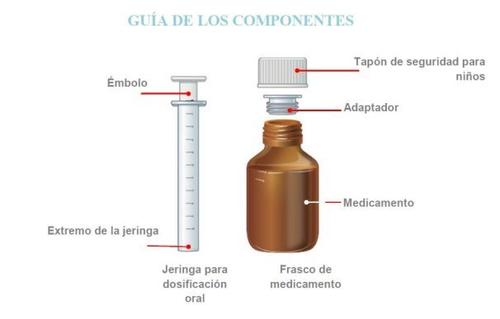 .ВАЖНОНЕпозволяйте вашему ребенку принимать лекарство без вашей помощи.НЕиспользуйте лекарство, если оно просрочено (проверьте дату истечения срока годности на этикетке).НЕиспользуйте лекарство, если прошло более 45 дней с момента первого открытия флакона. См. раздел Утилизациядля получения более подробной информации о том, что делать с лекарством, которое больше не используется.НЕмойте шприц для перорального дозирования мылом или моющим средством. НЕкладите шприц в посудомоечную машину. Если вы это сделаете, шприц может не работать так, как должен. Пожалуйста, см. инструкции по очистке с шага N по P.Не рекомендуется смешивать СТРАТТЕРУ пероральный раствор с пищей или водой, поскольку это может повлиять на вкус или предотвратить прием полной дозы.СТРАТТЕРА вызывает раздражение глаз. Избегайте контакта с глазами.Если лекарство попадает в глаза, промойте их немедленно водой и проконсультируйтесь с вашим врачом. Мойте руки и поверхности, которые могли соприкоснуться с лекарством, как можно скорее.
.ВАЖНОНЕпозволяйте вашему ребенку принимать лекарство без вашей помощи.НЕиспользуйте лекарство, если оно просрочено (проверьте дату истечения срока годности на этикетке).НЕиспользуйте лекарство, если прошло более 45 дней с момента первого открытия флакона. См. раздел Утилизациядля получения более подробной информации о том, что делать с лекарством, которое больше не используется.НЕмойте шприц для перорального дозирования мылом или моющим средством. НЕкладите шприц в посудомоечную машину. Если вы это сделаете, шприц может не работать так, как должен. Пожалуйста, см. инструкции по очистке с шага N по P.Не рекомендуется смешивать СТРАТТЕРУ пероральный раствор с пищей или водой, поскольку это может повлиять на вкус или предотвратить прием полной дозы.СТРАТТЕРА вызывает раздражение глаз. Избегайте контакта с глазами.Если лекарство попадает в глаза, промойте их немедленно водой и проконсультируйтесь с вашим врачом. Мойте руки и поверхности, которые могли соприкоснуться с лекарством, как можно скорее.
ШАГ 1 НАЧАЛЬНАЯ НАСТРОЙКА ФЛАКОНА
| Только перед первым использованием, нажмите адаптер до тех пор, пока он не будет полностью установленна флакон. Не собирайте шприц с адаптером, пока адаптер полностью не будет вставлен в флакон.НЕповорачивайте адаптер.ПРЕДУПРЕЖДЕНИЕ:Адаптер представляет риск удушья, поскольку является небольшим компонентом. Для безопасного использования он должен быть полностью вставлен в флакон. |
ШАГ 2 ПОДГОТОВКА
| Соберите все необходимые элементы:
|
| Мойте руки водой и мылом |
Напишите дозу вашего ребенка здесь: ____ мл Убедитесь, что это точная доза, которую назначил врач вашего ребенка.ЕСЛИ ДОЗА ВАШЕГО РЕБЕНКА10 мл ИЛИ МЕНЕЕ,вы будете использовать шприц 1 раз ЕСЛИ ДОЗА ВАШЕГО РЕБЕНКАБОЛЕЕ 10 млно НЕ более 20 мл, вы будете использовать один и тот же шприц 2 раза.ЕСЛИ ДОЗА ВАШЕГО РЕБЕНКАБОЛЕЕ 20 мл,вы будете использовать один и тот же шприц 3 раза.ШАГ 3 ПОЛУЧЕНИЕ ДОЗЫ
| Нажмите крышку по часовой стрелке, пока она не будет полностью откручена. Снимите крышку с флакона. |
| Нажмите на поршень полностью до конца шприца. |
| Вставьте кончик шприца в адаптер. Убедитесь, что кончик шприца полностью установлен в адаптере. |
| Наклоните флакон и шприц вниз. |
| Держите флакон и шприц одной рукой. Другой рукой, потяните поршень вниз, чтобы извлечь необходимое количество лекарства в шприц. Проверьте, что доза в шприце правильная. |
| Наклоните флакон вверх и положите его на ровную поверхность. Проверьте, что нет воздушных пузырей в шприце. Если есть, верните лекарство в флакон и повторите шаги с D по H. Воздушный пузырь может привести к неправильной дозе. |
| Удалите шприц из флакона. НЕтрогайте поршень. |
ШАГ 4 ПРИМЕНЕНИЕ ЛЕКАРСТВА
| Поместите кончик шприца на одну сторону рта вашего ребенка. Скажите вашему ребенку, чтобы он не кусал шприц. |
| Нажмите на поршень вниз до тех пор, пока ВСЕлекарство не окажется во рту вашего ребенка.НЕнаправляйте лекарство直接 в горло вашего ребенка. Убедитесь, что ваш ребенок проглотил все лекарство. |
| ЕСЛИ ДОЗА ВАШЕГО РЕБЕНКАБОЛЕЕ 10 мл, повторите шаги с D по K, чтобы дать оставшуюся дозу. Используйте один и тот же шприц. СМ. ТАБЛИЦУ ДОЗИРОВКИна другой стороне этого документа. Убедитесь, что вы даете точную дозу, которую назначил врач вашего ребенка. |
ШАГ5ОЧИСТКАСТОРОНА 1
| Завинтите крышку флакона плотно. НЕудаляйте адаптер. Крышка будет подходить. |
| Наполните стакан чистой водой.НЕмойте шприц для перорального дозирования мылом или моющим средством.НЕудаляйте поршень из шприца для перорального дозирования. Поместите кончик шприца в воду. Потяните поршень вверх, чтобы наполнить его водой. |
| Нажмите на поршень вниз и опустошите воду в стакан или в раковину. |
| Удалите излишки воды из шприца. Промокните шприц бумажным полотенцем. |
| Мойте руки и руки вашего ребенка мылом и водой.НЕтрогайте глаза после контакта со СТРАТТЕРОЙ.СТРАТТЕРА может раздражать ваши глаза. |
См. другую сторону этого документа, чтобы получить ответы на наиболее часто задаваемые вопросы, проверить ТАБЛИЦУ ДОЗИРОВКИи получить другую важную информацию.
СТОРОНА 2
ТАБЛИЦА ДОЗИРОВКИДЛЯДОЗБОЛЕЕ10млИспользуйте эту таблицу, чтобы рассчитать дозу, которую необходимо дать вашему ребенку. Найдите правильную дозу в первом столбце. Проконсультируйтесь с вашим врачом или фармацевтом, как дать правильную дозу вашему ребенку.
ЕСЛИ ЭТО ДОЗА ВАШЕГО РЕБЕНКА | ПОМЕСТИТЕ ЭТО КОЛИЧЕСТВО СТРАТТЕРЫ В ШПРИЦ, ВПЕРВЫЕ | ПОМЕСТИТЕ ЭТО КОЛИЧЕСТВО СТРАТТЕРЫ В ШПРИЦ, ВТОРОЙ РАЗ | ПОМЕСТИТЕ ЭТО КОЛИЧЕСТВО СТРАТТЕРЫ В ШПРИЦ, В ТРЕТИЙ РАЗ |
11 мл | 10 мл | 1 мл | 0 |
12 мл | 10 мл | 2 мл | 0 |
13 мл | 10 мл | 3 мл | 0 |
14 мл | 10 мл | 4 мл | 0 |
15 мл | 10 мл | 5 мл | 0 |
16 мл | 10 мл | 6 мл | 0 |
17 мл | 10 мл | 7 мл | 0 |
18 мл | 10 мл | 8 мл | 0 |
19 мл | 10 мл | 9 мл | 0 |
20 мл | 10 мл | 10 мл | 0 |
21 мл | 10 мл | 10 мл | 1 мл |
22 мл | 10 мл | 10 мл | 2 мл |
23 мл | 10 мл | 10 мл | 3 мл |
24 мл | 10 мл | 10 мл | 4 мл |
25 мл | 10 мл | 10 мл | 5 мл |
Часто задаваемые вопросыВ.Что происходит, если в шприце для перорального дозирования есть воздушный пузырь?О.НЕдавайте лекарство вашему ребенку. Воздушные пузыри могут сделать дозу неправильной. Опустошите лекарство обратно в флакон и повторите шаги с D по H.В.Что происходит, если в шприце слишком много лекарства?О.Держите кончик шприца в флаконе. Держите флакон вверх. Нажмите на поршень вниз до тех пор, пока правильная доза не окажется в шприце. В.Что происходит, если в шприце недостаточно лекарства?О.Держите кончик шприца в флаконе. Держите флакон вниз. Потяните поршень вниз до тех пор, пока правильная доза не окажется в шприце.В.Что я делаю, если лекарство попадает в мои глаза или глаза моего ребенка?О.Промойте глаза немедленно водой и проконсультируйтесь с вашим врачом. Как можно скорее, мойте руки и поверхности, которые могли соприкоснуться с лекарством.В.Как я путешествую с этим лекарством?О. Убедитесь, что у вас достаточно СТРАТТЕРЫ на весь путь. Храните лекарство в безопасном месте вверх тормашками при комнатной температуре.В.Могу ли я смешивать СТРАТТЕРУ с пищей или водой перед тем, как дать ее моему ребенку?О. Не рекомендуется смешивать СТРАТТЕРУ пероральный раствор с пищей или водой. Это может повлиять на вкус раствора или предотвратить прием полной дозы. Ваш ребенок может выпить стакан воды после приема полной дозы лекарства.ХранениеЭто лекарство не требует специальных условий хранения. Держите флакон и шприц вне поля зрения и досягаемости детей.УтилизацияНе выбрасывайте лекарства直接 в раковину или мусор. Проконсультируйтесь с вашим фармацевтом, как утилизировать лекарства, которые больше не будут использоваться. Эти меры помогут защитить окружающую среду.

Сколько стоит СТРАТТЕРА 4 мг/мл ОРАЛЬНЫЙ РАСТВОР в Испании в 2025 году?
Средняя цена на СТРАТТЕРА 4 мг/мл ОРАЛЬНЫЙ РАСТВОР в ноябрь, 2025 года составляет около 106.15 евро. Финальная стоимость может зависеть от региона, конкретной аптеки и рецептурного статуса. Для точной информации лучше проверить онлайн или в ближайшей аптеке.
- Страна регистрации
- Средняя цена в аптеках106.15 EUR
- Наличие в аптекахПроблемы с поставками
- Активное вещество
- Требуется рецептДа
- Производитель
- Информация носит справочный характер и не является медицинской рекомендацией. Перед приемом любых препаратов проконсультируйтесь с врачом. Oladoctor не несет ответственности за медицинские решения, принятые на основе этого контента.
- Аналоги СТРАТТЕРА 4 мг/мл ОРАЛЬНЫЙ РАСТВОРФорма выпуска: КАПСУЛА, 10 мгАктивное вещество: atomoxetineПроизводитель: Laboratorios Rubio S.A.Требуется рецептФорма выпуска: КАПСУЛА, 100 мгАктивное вещество: atomoxetineПроизводитель: Laboratorios Rubio S.A.Требуется рецептФорма выпуска: КАПСУЛА, 18 мгАктивное вещество: atomoxetineПроизводитель: Laboratorios Rubio S.A.Требуется рецепт
Аналоги СТРАТТЕРА 4 мг/мл ОРАЛЬНЫЙ РАСТВОР в других странах
Лучшие аналоги с тем же действующим веществом и терапевтическим эффектом.
Аналог СТРАТТЕРА 4 мг/мл ОРАЛЬНЫЙ РАСТВОР в Польща
Аналог СТРАТТЕРА 4 мг/мл ОРАЛЬНЫЙ РАСТВОР в Україна
Врачи онлайн по СТРАТТЕРА 4 мг/мл ОРАЛЬНЫЙ РАСТВОР
Консультация по дозировке, побочным эффектам, взаимодействиям, противопоказаниям и продлению рецепта на СТРАТТЕРА 4 мг/мл ОРАЛЬНЫЙ РАСТВОР – по решению врача и с учетом местных правил.




